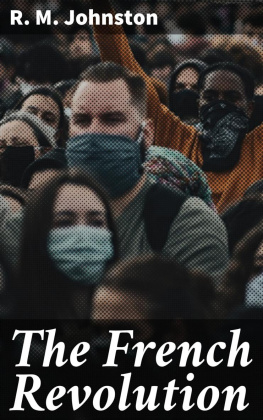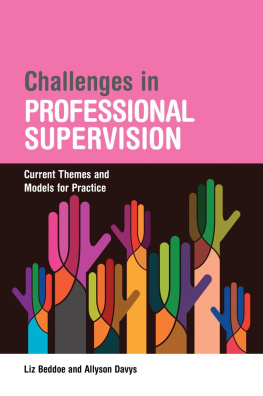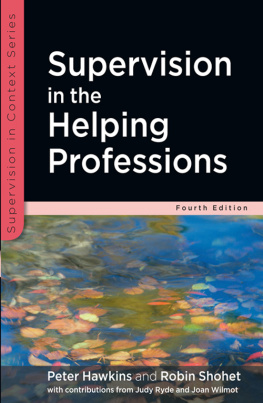Critical Supervision for
the Human Services
of related interest
Challenges in Professional Supervision
Current Themes and Models for Practice
Liz Beddoe and Allyson Davys
ISBN 978 1 84905 465 2
eISBN 978 0 85700 843 5
Best Practice in Professional Supervision
A Guide for the Helping Professions
Allyson Davys and Liz Beddoe
ISBN 978 1 84310 995 2
eISBN 978 0 85700 384 3
Practical Supervision
How to Become a Supervisor for the Helping Professions
Penny Henderson, Jim Holloway and Anthea Millar
Foreword by Brigid Proctor and Francesca Inskipp
ISBN 978 1 84905 442 3
eISBN 978 0 85700 918 0
Supervision as Transformation
A Passion for Learning
Edited by Robin Shohet
Foreword by Ben Fuchs
ISBN 978 1 84905 200 9
eISBN 978 0 85700 509 0
Passionate Supervision
Edited by Robin Shohet
Foreword by Peter Hawkins
ISBN 978 1 84310 556 5
eISBN 978 1 84642 749 7
Mastering Social Work Supervision
Jane Wonnacott
ISBN 978 1 84905 177 4
eISBN 978 0 85700 403 1
Critical
Supervision
for the Human
Services
A Social Model to Promote Learning and
Values-Based Practice
Carolyn Noble, Mel Gray and Lou Johnston
Jessica Kingsley Publishers
London and Philadelphia
reproduced by permission of SAGE Publications, London, Los Angeles, New Delhi and Singapore, from Hughes and Wearing, Organisations and Management in Social Work (2e), Copyright (SAGE Publications, 2013).
reproduced by permission of McGraw-Hill Education, London, from Hawkins and Shohet (2012). Supervision in the helping professions (4th ed.).
reproduced by permission of Cengage Learning, from Beddoe and Maidment (2009). Mapping knowledge for social work practice: Critical intersections.
First published in 2016
by Jessica Kingsley Publishers
73 Collier Street
London N1 9BE, UK
and
400 Market Street, Suite 400
Philadelphia, PA 19106, USA
www.jkp.com
Copyright Carolyn Noble, Mel Gray and Lou Johnston 2016
Front cover image source: Barry Jon Gray.
All rights reserved. No part of this publication may be reproduced in any material form (including photocopying or storing it in any medium by electronic means and whether or not transiently or incidentally to some other use of this publication) without the written permission of the copyright owner except in accordance with the provisions of the Copyright, Designs and Patents Act 1988 or under the terms of a licence issued by the Copyright Licensing Agency Ltd, Saffron House, 610 Kirby Street, London EC1N 8TS. Applications for the copyright owners written permission to reproduce any part of this publication should be addressed to the publisher.
Warning: The doing of an unauthorised act in relation to a copyright work may result in both a civil claim for damages and criminal prosecution.
Library of Congress Cataloging in Publication Data
A CIP catalog record for this book is available from the Library of Congress
British Library Cataloguing in Publication Data
A CIP catalogue record for this book is available from the British Library
ISBN 978 1 84905 589 5
eISBN 978 1 78450 043 6
CONTENTS
LIST OF FIGURES AND TABLES
FIGURES
TABLES
Introduction
With the overriding focus on key performance indicators and strategic outcomes, supervisory practice has changed dramatically in recent years. Formal services, including those provided by human services practitioners, are said to be experiencing a crisis brought on by the ideologically entrenched neoliberal culture that is increasingly shaping welfare reform in many parts of the developed Western world, and in developing countries through conditional development aid policies. Taking an emancipatory stance to undermine inequality, poverty, oppression, discrimination and white privilege has become increasingly difficult in this political landscape (Pease, 2010). At the same time, much of the professional discourse continues to emphasise reflective practice as the preferred option. This does not provide suitable scope to negotiate and critique complex organisational environments and consider solutions to the equally complex aspects of contemporary human service work (Adamson, 2012; Davys and Beddoe, 2010; Driscoll, 2007; Hawkins and Shohet, 2012; Henderson, 2009; Hughes and Pengelly, 1997). These few examples of what is happening in the contemporary human services landscape demonstrate the need for critical supervision, so the social professions might fulfil their public responsibility to confront injustice while seeking justice for all (Gray and Webb, 2013a, p.3). Critical supervision can play a pivotal role in reengaging practitioners and the service users they encounter in finding effective ways of achieving this overriding goal.
This book offers a needed resource for practising and developing supervision from a critical perspective. Its distinguishing feature is its critical focus on learning in and through supervision, bringing together critical theories and perspectives, critical pedagogy and transformative practice within a learning organisation model. Through presenting a critical supervision model and using practice examples, it explores the idea of critical supervision for those involved in human services, social care and allied health contexts, including practitioners, managers, policy analysts, researchers and academics. In particular, this book examines contemporary ideas on supervision practice through a critical lens. Its appeal lies in the applicability of the ideas presented, discussed and analysed to a broad range of human service contexts, such as child protection, drug and alcohol work, mental health, criminal justice and health, where a range of services is provided by inter alia social workers, counsellors, adult educators, youth workers, community workers, psychologists, occupational and speech therapists, and nurses. The book will resonate with readers experiences within these diverse environments and provide much-needed guidance for a critical approach to practice improvement, professional and organisational development, and lifelong learning through supervision.
There are any number of books on professional or clinical supervision that have been published in recent years (Carroll, 2009, 2010, 2011, 2014; Chesner and Zografou, 2013; Davys and Beddoe, 2010; Edwards, 2013; Engelbrecht, 2014; Hawkins and Shohet, 2012; Haynes, Corey and Moulton, 2003; Henderson, 2009; Henderson, Holloway and Millar, 2014; Howe and Gray, 2013; Hughes and Pengelly, 1997; Kadushin and Harkness, 2014; Scaife, 2010; Schuck and Wood, 2011; Shohet, 2008, 2011; Weld, 2012; Wonnacott, 2012). These are complemented with an increasing focus on supervision in journals and in research (e.g. Beddoe, 2010, 2012; Collins-Camargo and Royse, 2010; Dill and Bogo, 2009; Egan, 2012; Gibbs, 2001, 2009; Manthorpe et al., 2015; ODonoghue, 2012, 2014; ODonoghue and Tsui, 2015). This signals a renewed interest in supervision.
As the authors of this book, we bring a combination of academic and practice experience from our collective interest in the exact nature and purpose of critical practice in the social professions and how it can be linked to professional supervision. Though we are all social workers, what we have to say has appeal for a much wider audience concerned with social change, including artists, environmentalists, health professionals, educators and the like. As social workers, we began by asking ourselves, what is the exact nature of the work we do? What lies behind the very idea of an occupation engaged in working on the social? What is the social? And, what do other social professionals have to say about how they work that might resonate for other occupations in the human services sector?









